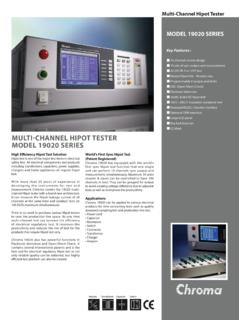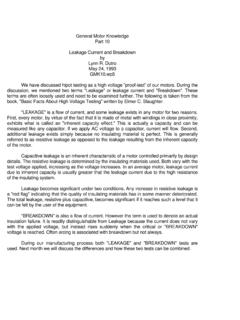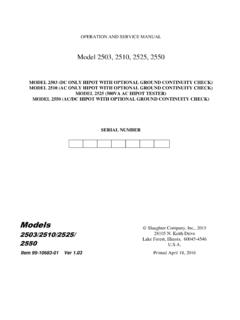Transcription of TAN δ (DELTA) CABLE TESTING OVERVIEW AND …
1 TAN ( delta ) CABLE TESTING OVERVIEW AND ANSWERS TO FREQUENTLY ASKED QUESTIONS What Is Tan , Or Tan delta ? Tan delta , also called Loss Angle or Dissipation Factor TESTING , is a diagnostic method of TESTING cables to determine the quality of the CABLE insulation. This is done to try to predict the remaining life expectancy and in order to prioritize CABLE replacement and/or injection. It is also useful for determining what other tests may be worthwhile. How Does It Work? If the insulation of a CABLE is free from defects, like water trees, electrical trees, moisture and air pockets, etc., the CABLE approaches the properties of a perfect capacitor. It is very similar to a parallel plate capacitor with the conductor and the neutral being the two plates separated by the insulation material.
2 In a perfect capacitor, the voltage and current are phase shifted 90 degrees and the current through the insulation is capacitive. If there are impurities in the insulation, like those mentioned above, the resistance of the insulation decreases, resulting in an increase in resistive current through the insulation. It is no longer a perfect capacitor. The current and voltage will no longer be shifted 90 degrees. It will be something less than 90 degrees. The extent to which the phase shift is less than 90 degrees is indicative of the level of insulation contamination, hence quality/reliability. This Loss Angle is measured and analyzed. Below is a representation of a CABLE . The tangent of the angle is measured.
3 This will indicate the level of resistance in the insulation. By measuring IR/IC (opposite over adjacent the tangent), we can determine the quality of the CABLE insulation. In a perfect CABLE , the angle would be nearly zero. An increasing angle indicates an increase in the resistive current through the insulation, meaning contamination. The greater the angle, the worse the CABLE . IVIRICIC + IR CableCircuitRC What Are Water Trees? Water trees are small tree shaped channels found within the insulation of a CABLE , caused by the presence of moisture. They are very prevalent in service aged XLPE and other solid dielectric cables, like PE and EPR cables. These tree shaped moisture channels, in the presence of an electrical field, eventually lead to the inception of partial discharge (pd), which eventually leads to the formation of electrical trees, which grow to a point where insulation failure occurs.
4 The tan delta test shows the extent of water tree damage in a CABLE . What Hardware Is Necessary? The tan delta unit consists of a high voltage divider and a fiber optically linked measurement box. The high voltage divider measures the voltage and current input to the CABLE , sends this information to the controller, which analyzes the voltage and current waveforms and calculates the tan delta number. A connected laptop computer displays and stores the results. A voltage source is needed to energize the CABLE . What is typically used is a Very Low Frequency (VLF) AC hipot . The VLF pictured here is a 40 kV (peak) unit that is capable of TESTING from uF of CABLE load at Hz, up to at Hz. Other models offer an output frequency of Hz, used to test very long cables.
5 VLF hipots are also widely used for TESTING newly installed and/or repaired CABLE before reenergizing to insure the CABLE is sound and for TESTING critical CABLE runs. VLF-4022CM, 0 40kVAC Tan delta unit Test set up Loss AngleAnalyzerVLF ControlVLFM easuring UnitCable Under TestFiber Optic CablesHV Tank How Is The Test Performed? The CABLE to be tested must be de-energized and each end isolated. Using a VLF AC hipot , the test voltage is applied to the CABLE while the tan delta controller takes measurements. Typically, the applied test voltage is raised in steps, with measurements first taken up to 1Uo, or normal line to ground operating voltage.
6 If the tan delta numbers indicate good CABLE insulation, the test voltage is raised up to 2 Uo. The tan delta numbers at the higher voltages are compared to those at lower voltages and an analysis is made. Why Is A VLF hipot Used Instead Of A Regular 60 Hz Model. Two reasons. First, to test a CABLE with 60 Hz power requires a very high power supply. It is not practical, nearly impossible, to test a CABLE of several thousand feet with a 60 Hz supply. At a typical VLF frequency of , it takes 600 times less power to test the same CABLE compared to 60 Hz. Secondly, the magnitude of the tan delta numbers increase as the frequency decreases, making measurement easier. As the below equation shows, the lower the frequency (f), the higher the tan delta number.
7 Tan delta ( ) = IR/ IC = 1/(2pfCR) (tan delta is measured in radians) How Are The Test Results Interpreted And Is It Necessary To Have A Benchmark, Or Standard, Result For Comparison? While it is beneficial to have a standard or previous test to compare to for trending purposes, like with many diagnostic methods of TESTING , it is not necessary. The very first test on a CABLE yields valuable information about the insulation. Also, most tan delta TESTING is performed on a comparative basis. More on that in the next section. If a CABLE s insulation is perfect, the loss factor (tan delta ) will change little as the applied voltage is increased. The capacitance and loss will be similar with 1 kV or 10kV applied to the CABLE . If the CABLE has water tree contamination, thus changing the capacitive/resistive nature of the insulation, then the tan delta numbers will be higher at higher voltages.
8 Rather than a flat curve for the loss number versus voltage, the curve will be non linear. See the below graph. New and Aged 15 kV XLPE CABLE (Nov 2000) Voltage (kV rms)Loss Angle (Tan delta )Aged CableNew CableMeasurements are voltage dependent in an old are not voltage dependent in new this graph, we can see that the aged CABLE has extensive water tree damage. The Loss Angle increases with increasing voltage, indicating a high resistive current element to the insulation. These results can be compared to other cables tested to determine which cables are in need of immediate replacement and which can wait a bit longer. Also, many tests are measured on a comparative basis. Many of the same type of cables may be tested, with the results compared against each other.
9 An average value for the tan delta can be calculated and possibly used as a future benchmark. If There Are No Recognized Standards For Tan delta Test Values, What Good Is The Test? How Do We Know If A CABLE Is Good, Marginal, Or Bad? Fair question. It is correct to say that there is not an extensive library of test values for all types of cables and accessories. As mentioned earlier, much of the TESTING is done on a comparative basis, as with partial discharge TESTING , where established pd levels do not exist for all CABLE types, accessories, and varying installation methods. There is no reliable consensus on what are good versus bad pd levels. Splices can exhibit very high levels of partial discharge yet last for years, while those showing lower pd levels might fail sooner.
10 One must keep in mind what the purpose of the test is. Whether using partial discharge or tan delta techniques, the point of the test is to grade all cables tested on a scale from high quality to low. The point in the TESTING is to help a utility prioritize CABLE replacement or injection. Again, comparative TESTING will show which cables are worse than others and will, over time, permit the user to develop their own in-house guidelines, unique to their situation. In the real world, once a utility tests hundreds of cables and grades them from good to bad, giving them a starting point for CABLE replacement, they generally run out of time and money long before they get to the cables that were marginal. This fact also demonstrates that tan delta TESTING is not an exact, precise test.





